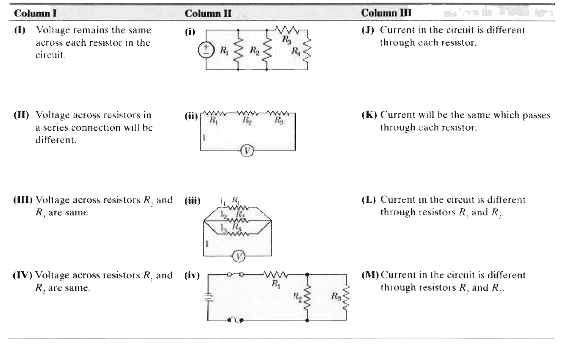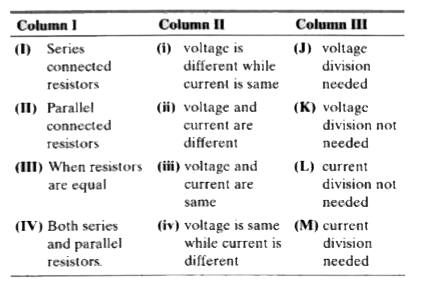There are mainly two types of combinations of resistors in a circuit, series and parallel. In the given table, Column I shows voltages of different arrangements of resistors, Column II shows different arrangement of resistors and Column III shows currents of different arrangements of resistors.
What are the conditions when resistors are in mixed combination, that is, parallel and series combination respectively?

(IV) (iv) (K)
(III) (iv) (M)
(II) (iii) (L)
(I) (i) (M)
The correct Answer is:B
Topper's Solved these Questions
- CURRENT AND RESISTANCEBOOK - RESNICK AND HALLIDAYCHAPTER - CURRENT AND RESISTANCEEXERCISE - Practice Questions (Integer Type)
3 Videos
- CURRENT AND RESISTANCEBOOK - RESNICK AND HALLIDAYCHAPTER - CURRENT AND RESISTANCEEXERCISE - Practice Questions (Linked Comprehension)
5 Videos
- CIRCULAR MOTIONBOOK - RESNICK AND HALLIDAYCHAPTER - CIRCULAR MOTIONEXERCISE - CHECK POINTS
6 Videos
- ELASTICITYBOOK - RESNICK AND HALLIDAYCHAPTER - ELASTICITYEXERCISE - PRACTICE QUESTIONS (Integer Type)
3 Videos
Similar Questions
Knowledge Check
There are mainly two types of combinations of resistors in a circuit, series and parallel. In the given table, Column I shows voltages of different arrangements of resistors, Column II shows different arrangement of resistors and Column III shows currents of different arrangements of resistors.
What are the conditions when resistors are in mixed combination, that is series and parallel combination respectively?
 A(III) (i) (L)B(I) (i) (J)C(IV) (i) (L)D(II) (iii) (M)
A(III) (i) (L)B(I) (i) (J)C(IV) (i) (L)D(II) (iii) (M)There are mainly two types of combinations of resistors in a circuit, series and parallel. In the given table, Column I shows voltages of different arrangements of resistors, Column II shows different arrangement of resistors and Column III shows currents of different arrangements of resistors.
What are the conditions when resistor is in the parallel network?
 A(I) (ii) (J)B(IV) (ii) (M)C(II) (ii) (J)D(I) (iii) (J)
A(I) (ii) (J)B(IV) (ii) (M)C(II) (ii) (J)D(I) (iii) (J)Electrical current is the flow of charged particles. The electric current flows through a wire the same way as how water moves in a river. The electricity is nothing but the flow of electrons. There are two main combinations of resistors in circuit, that is series and parallel. In the given table, Column I shows different combinations of resistors, Column II shows voltages of different arrangements of resistors and Column III shows currents and voltage division needed or not in different arrangements of resistors.

When there is no voltage division problem arise?A(II) (iv) (K)B(IV) (i) (M)C(III) (ii) (L)D(III) (iv) (K)
When two resistors are in parallel combination then determine i1 and i2 if the combination carries a current I ?

View SolutionWhen two resistors are in parallel combination then determine i1 and i2 if the combination carries a current I ?

View SolutionRevise Combination of Resistors In Series And Parallel|Questions|Practice Exercise|Summary
View SolutionElectrical current is the flow of charged particles. The electric current flows through a wire the same way as how water moves in a river. The electricity is nothing but the flow of electrons. There are two main combinations of resistors in circuit, that is series and parallel. In the given table, Column I shows different combinations of resistors, Column II shows voltages of different arrangements of resistors and Column III shows currents and voltage division needed or not in different arrangements of resistors.

When does the current division problem arise?
View SolutionElectrical current is the flow of charged particles. The electric current flows through a wire the same way as how water moves in a river. The electricity is nothing but the flow of electrons. There are two main combinations of resistors in circuit, that is series and parallel. In the given table, Column I shows different combinations of resistors, Column II shows voltages of different arrangements of resistors and Column III shows currents and voltage division needed or not in different arrangements of resistors.

When does the voltage division problem arise?
View Solution
